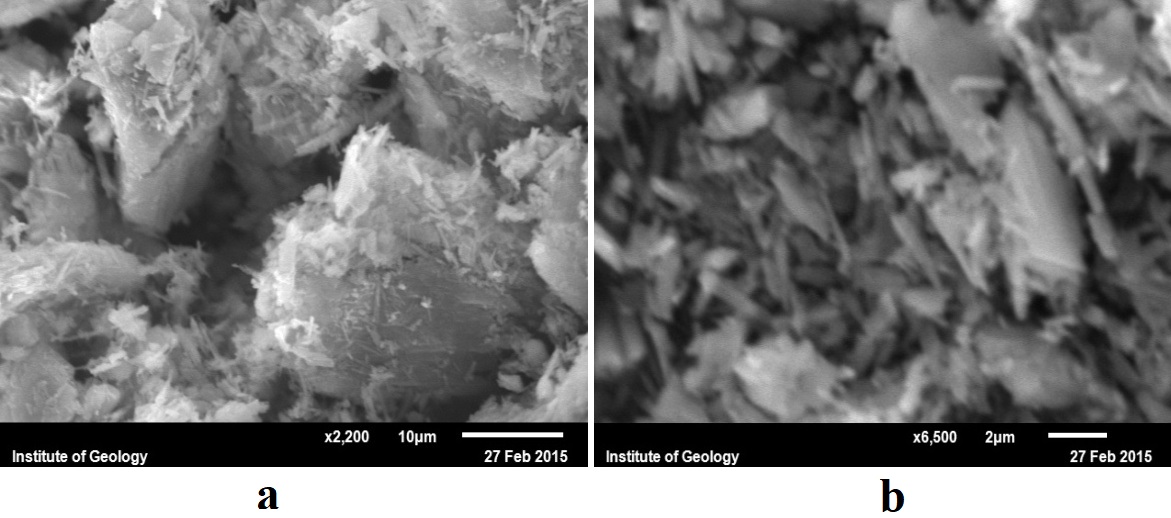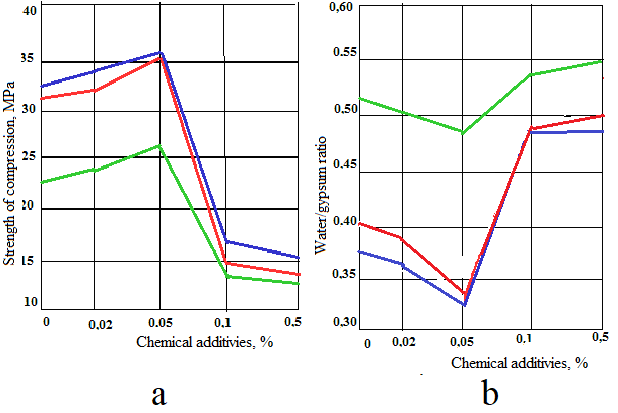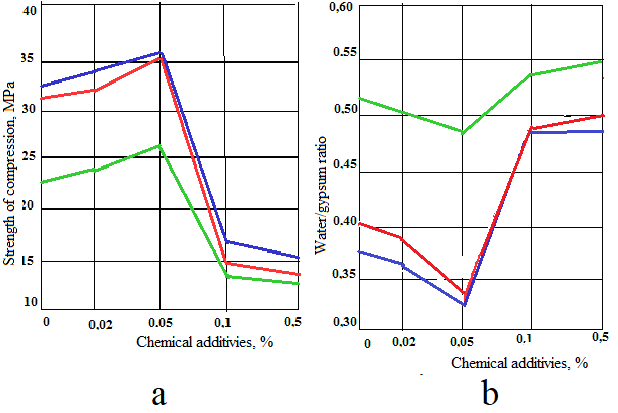Исследование влияния химических добавок на превращение дигидрата гипса в α-полугидрат гипса
Исследование влияния химических добавок на превращение дигидрата гипса в α-полугидрат гипса
Аннотация
Химические добавки, такие как щавелевая кислота и янтарная кислота, использовались для повышения влагостойкости и долговечности гипсовых вяжущих. Исследовано влияние химических добавок на превращение гипсового камня в гипсовый вяжущий. Установлено, что химические добавки улучшают свойства гипсовых вяжущих.
Известно, что в процессе гидротермической обработки клей, полученный при переходе гипсового камня в ɑ-полугидратный гипс, становится очень мелкими, не требует теоретического измельчения гипса по этой технологии. Однако опыт показывает, что гипсовые вяжущие в процессе технологического процесса комкуются, и кристаллы ɑ-полугидрата гипса слипаются друг с другом, что приводит к дополнительному измельчению вяжущего. Это приводит к разрушению кристаллов гипса в ɑ-полугидратном гипсе, снижению прочности. В представленном исследовании предложено устранить этот недостаток добавлением органических кислот.
При этом изучено влияние добавки ультрадисперсного метаколина на свойства α-полуводного гипса и установлено, что водостойкость вяжущего значительно повышается при использовании ультрадисперсной добавки метаколина с небольшим количеством извести.
1. Introduction
The rise in energy resources impedes the use of more efficient building materials. In recent years, the use of porous concrete and effective ceramic bricks and stones has also been used in the construction of high-rise buildings in the Republic. The use of high thermal-physical properties of construction materials not only reduces the weight of the structures, but also plays a role of effective thermal insulation material during operation.
Hence, when using porous light concrete, effective brick and ceramic stones in the construction of partitions, a more suitable solution should be used for their surface watering. These solutions should also be prepared on the basis of gypsum adhesives, which have high environmental properties and are more economically efficient adhesives.
However, it is known that the durability of the construction plaster is not high enough and the low quality of the products made on its basis is low.
2. Main Part
2.1. Purpose of the Article
The purpose of the research is to improve the construction and technical properties of gypsum adhesives. To achieve this goal, it is important to conduct the following research:
- to study the effect of organic acids on the properties of autoclaved gypsum adhesives;
- To study the effect of ultradisperse additives with high chemical activity on the properties of high-strength gypsum.
2.2. Research Methodology
To determine the physical and mechanical properties of gypsum binder, standard methods have been used . To study the microstructure of gypsum binder, microscopy methods have been used . Microscopy analysis was performed on a FE-SEM Qvanta 400 F scanning electron microscope (Filips, Netherlands).
2.3. Results
Various types of additives are used in modern times to adjust the properties of plaster adhesives. These supplements can be both chemical and mineral supplements. The effects of mineral additives on gypsum adhesives have been studied by researchers , , , . The process of reinforcing such composite adhesives occurs as a result of more complex physical and chemical processes. In this case, first the semihydrate gypsum is reinforced (converted into dihydrate gypsum), then the ingredients in the mineral component are involved in the solidification and the adhesive material with complex properties, depending on the type of mineral supplement.
Microscopic studies have shown that in the process of hydrothermal processing, crystals of gypsum stone occur when the transition to ɑ-semihydrate gypsum crystals is broken down into small particles, so that the gypsum adhesive obtained by this technology does not need to be ground. However, experience does not confirm this. Gypsum adhesives are sharpened, ɑ-semihydrate gypsum crystals adhere to each other, resulting in additional grinding of the adhesive. This causes disruption of the crystals of gypsum in the ɑ-semihydrate, reducing the adhesive strength. According to the results of some research experiments , , this deficiency can be eliminated by the addition of hydrating organic acids.
At the initial stage of the study, the aim was to study the effect of different amounts of organic acids on the crystallization of gypsum in an autoclave.
The study was carried out by controlling the autoclave process and capturing microscopic images of the obtained material electron microscopy.
0.05 from amber and acral acids as acid supplement 0.1; 0.2 and 0.5% were used. The new formation is shown in Figure 1. Analysis of the photos presented shows that the addition of organic acids has a significant impact on the shape and size of the crystals.
Increase in the amount of acids to a certain extent (up to 0.05%) has a positive effect on the mechanical properties of the plaster adhesive. Increasing the amount of chemical additives to 0.1% caused a 61% decrease in the strength of the sample. No increase in strength is observed when the number of supplements increases to 0.5%.

Figure 1 - Micropictures of gypsum adhesive:
a - without additives chemical additives; b - with chemical additives
The effects of chemical additives on the properties of high-strength gypsum adhesives can be seen in the graphs in Figure 2 and Figure 3.

Figure 2 - Influence of amino acid on the properties of high-strength gypsum adhesives:
a - strength of compression; b - water/gypsum ratio; blue - the duration of the hydrothermal treatment is 6 hours; red - 4 hours hydrothermal processing; green - duration of hydrothermal treatment is 2 hours

Figure 3 - Influence of acetic acid on the properties of high-strength gypsum adhesives:
a - strength of compression,MPa; b - water / plaster ratio; blue - the duration of the hydrothermal treatment is 6 hours; red - 4 hours hydrothermal processing; green - duration of hydrothermal treatment is 2 hours
The metakaolin supplements significantly increase the mechanical strength of the adhesive consisting of gypsum and lime mixture and at the same time has a beneficial effect on water resistance. The results of the experiment are shown in Table 1.
The strength of the material obtained from the consolidation of 7% metakaolin and 5% lime mixture increased by 30%, the water-resistance index (softening factor) increased from 0.4 to 0.69. And this is 2 times more than water resistance of the product made of gypsum adhesives. At the same time, any increase in the strength of the material in the specimen (specimen No. 3) is not observed where lime is not added.
According to researchers , when adding ultra disperse particles to the gypsum binding, the number of contact points increases during hardening, consequently, each solid particle is surrounded by a liquid phase, which reflects itself in the formation kinetics of the coagulative contacts. According to the results of the authors' , researches, it is possible to obtain a higher effect, if these particles are derived from (like lime) the granulating of inorganic material which is crystall-ochemical analogous of gypsum adhesives.
Table 1 - Impact of metakaolin additives on properties of gypsum binder
No | Material quantity, % | Stiffness limit of the specimen in compression, MPa | Softening factor | |||
gypsum | lime | metakaolin | water | |||
1 | 100 | - | - | 35 | 13,3 | 0,40 |
2 | 97 | 3 | - | 33 | 13,0 | 0,40 |
3 | 97 | - | 3 | 36 | 14,2 | 0,42 |
4 | 94 | 3 | 3 | 35 | 15,6 | 0,49 |
5 | 90 | 5 | 5 | 37 | 17,0 | 0,64 |
6 | 88 | 5 | 7 | 38 | 17,5 | 0,69 |
Along with increased durability of rocky materials obtained with the gypsum adhesives processing with ultradispers metakaolin and lime, there is also a significant increase in water resistance. The use of 7% of metakaolin and 5% of lime have doubled the water resistance factor of the material.
2.4 Scientific Novelty
It has been found experimentally that the use of chemical additives promotes the conversion of bihydrate crystals into α-semi-hydrate crystals and the process of correcting their shape and size, thus improving the physical and technical properties of the obtained adhesive.
The improvement of the ɑ-modification properties of semi-aqueous gypsum by the addition of ultradispers metacaolin has been experimentally proven, and the effectiveness of this supplement has been studied and substantiated by modern physico-chemical analysis methods.
2.5. Practical Importance
The positive effect of chemical additives on the properties of gypsum adhesives obtained by hydrothermal treatment allows the wider use in construction of an environmentally friendly, low-energy adhesive material such as gypsum.
The development of technology for the production of gypsum adhesives with high construction and technical properties using the addition of ultradispers metacaolin and, consequently, the increase in the efficiency of the use of gypsum adhesives by increasing their moisture content and strength increases the practical importance of research.
It is also of practical importance to develop a technology for the production of high-strength gypsum adhesive from gypsum of various fractions and microstructures, thereby increasing the efficiency of the use of gypsum raw materials and thus expanding their field of application as a result of improving the properties of gypsum adhesives.
3. Conclusion
Each natural gypsum stone used as a raw material for the production of high-strength gypsum adhesive must have a certain hydrothermal treatment regime for autoclave processing. In our study, the optimal mode was steam pressure of 0.5-0.7 MPa, isothermal storage of 4–6 hours. In this case, the amount of residual and secondary bicarbonate is minimal.
In the process of hydrothermal processing of gypsum, its crystals are transformed into a new phase fine crystals of α-semi-hydrate calcium sulfate, thus having a "self-crushing" effect. The choice of fraction composition, type and amount of chemical additive, as well as parameters of hydrothermal treatment shows that this process is correct in practice. The use of chemical additives promotes the conversion of bicarbonate crystals into α-semi-hydrate crystals and the process of correcting their shape and size, thus improving the physical and technical properties of the obtained adhesive.
The use of ultra-dispersed metacaolin supplementation also had a positive effect on the properties of α-hemihydrate. Thus, the addition of 7% ultradispers metacaolin and 5% lime supplement doubles the water resistance of the adhesive.
